 dotReader, “an open source, cross-platform content reader/management system with an extensible, plug-in architecture,” is available now in beta for Windows and Linux, and should be out for Mac any day now. For now, dotReader is just for reading but a content creation tool is promised for the very near future.
dotReader, “an open source, cross-platform content reader/management system with an extensible, plug-in architecture,” is available now in beta for Windows and Linux, and should be out for Mac any day now. For now, dotReader is just for reading but a content creation tool is promised for the very near future.
The reader has some nice features like shared bookmarks and annotations, a tab system for moving between multiple texts and an embedded web browser. In many ways it feels like a web browser that’s been customized for books. I can definitely see it someday becoming a fully web-based app. The recently released Firefox 2 has a bunch of new features like live bookmarks (live feed headlines in drop-down menus on your bookmarks toolbar) and a really nice embedded RSS reader. It’s a pretty good bet that online office suites, web browsers and standalone reading programs are all on the road to convergence.
Congrats to the OSoft team and to David Rothman of Teleread, who has worked with them on implementing the Open Reader standard in dotReader.
Monthly Archives: November 2006
getting beyond accuracy in the wikipedia debate
First Monday has published findings from an “empirical examination of Wikipedia’s credibility” conducted by Thomas Chesney, a Lecturer in Information Systems at the Nottingham University Business School. Chesney divided participants in the study — 69 PhD students, research fellows and research assistants — into “expert” and “non-expert” groups. This meant that roughly half were asked to evaluate an article from their field of expertise while the others were given one chosen at random (short “stub” articles excluded). The surprise finding of the study is that the experts rated their articles higher than the non-experts. Ars Technica reported this as the latest shocker in the debate over Wikipedia’s accuracy, hearkening back to the controversial Nature study comparing science articles with equivalent Britannica entries.
At a first glance, the findings are indeed counterintuitive but it’s unclear what, if anything, they reveal. It’s natural that academics would be more guarded about topics outside their area of specialty. The “non-experts” in this group were put on less solid ground, confronted at random by the overwhelming eclecticism of Wikipedia — it’s not surprising that their appraisal was more reserved. Chesney acknowledges this, and cautions readers not to take this as anything approaching definitive proof of Wikipedia’s overall quality. Still, one wonders if this is even the right debate to be having.
Accuracy will continue to be a focal point in the Wikipedia discussion, and other studies will no doubt be brought forth that add fuel to this or that side. But the bigger question, especially for scholars, concerns the pedagogical implications of the wiki model itself. Wikipedia is not an encyclopedia in the Britannica sense, it’s a project about knowledge creation — a civic arena in which experts and non-experts alike can collectively assemble information. What then should be the scholar’s approach and/or involvement? What guidelines should they draw up for students? How might they use it as a teaching tool?
A side note: One has to ask whether the experts group in Chesney’s study leaned more toward the sciences or the humanities — no small question since in Wikipedia it’s the latter that tends to be the locus of controversy. It has been generally acknowledged that science, technology (and pop culture) are Wikipedia’s strengths while the more subjective fields of history, literature, philosophy — not to mention contemporary socio-cultural topics — are a mixed bag. Chesney does never tells us how broad or narrow a cross section of academic disciplines is represented in his very small sample of experts — the one example given is “a member of the Fungal Biology and Genetics Research Group (in the Institute of Genetics at Nottingham University).”
Returning to the question of pedagogy, and binding it up with the concern over quality of Wikipedia’s coverage of humanities subjects, I turn to Roy Rosenzweig, who has done some of the most cogent thinking on what academics — historians in particular — ought to do with Wikipedia. From “Can History be Open Source? Wikipedia and the Future of the Past”:
Professional historians have things to learn not only from the open and democratic distribution model of Wikipedia but also from its open and democratic production model. Although Wikipedia as a product is problematic as a sole source of information, the process of creating Wikipedia fosters an appreciation of the very skills that historians try to teach…
Participants in the editing process also often learn a more complex lesson about history writing–namely that the “facts” of the past and the way those facts are arranged and reported are often highly contested…
Thus, those who create Wikipedia’s articles and debate their contents are involved in an astonishingly intense and widespread process of democratic self-education. Wikipedia, observes one Wikipedia activist, “teaches both contributors and the readers. By empowering contributors to inform others, it gives them incentive to learn how to do so effectively, and how to write well and neutrally.” The classicist James O’Donnell has argued that the benefit of Wikipedia may be greater for its active participants than for its readers: “A community that finds a way to talk in this way is creating education and online discourse at a higher level.”…
Should those who write history for a living join such popular history makers in writing history in Wikipedia? My own tentative answer is yes. If Wikipedia is becoming the family encyclopedia for the twenty-first century, historians probably have a professional obligation to make it as good as possible. And if every member of the Organization of American Historians devoted just one day to improving the entries in her or his areas of expertise, it would not only significantly raise the quality of Wikipedia, it would also enhance popular historical literacy. Historians could similarly play a role by participating in the populist peer review process that certifies contributions as featured articles.
brewster kahle on the google book search “nightmare”
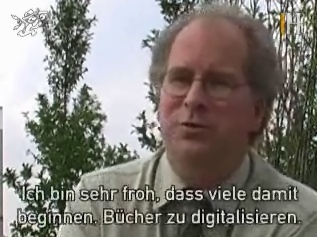
“Pretty much Google is trying to set themselves up as the only place to get to these materials; the only library; the only access. The idea of having only one company control the library of human knowledge is a nightmare.”
From a video interview with Elektrischer Reporter (click image to view).
(via Google Blogoscoped)
google makes slight improvements to book search interface
Google has added a few interface niceties to its Book Search book viewer. It now loads multiple pages at a time, giving readers the option of either scrolling down or paging through left to right. There’s also a full screen reading mode and a “more about this book” link taking you to a profile page with links to related titles plus references and citations from other books or from articles in Google Scholar. Also on the profile page is a searchable keyword cluster of high-incidence names or terms from the text.
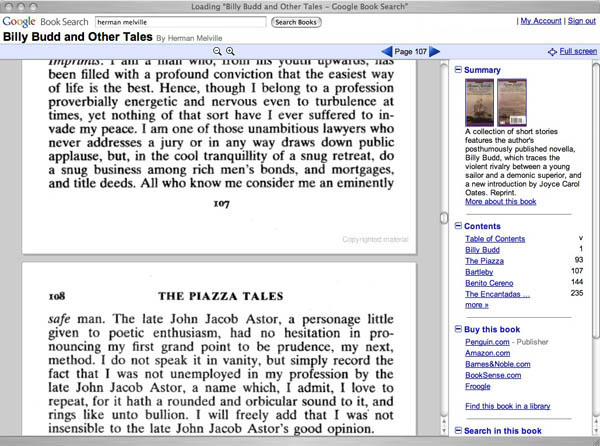
Above is the in-copyright Signet Classic edition of Billy Budd and Other Tales by Melville, which contains only a limited preview of the text. You can also view the entire original 1856 edition of Piazza Tales as scanned from the Stanford Library. Public domain editions like this one can now be viewed with facing pages.
Still a conspicuous lack of any annotation or social reading tools.
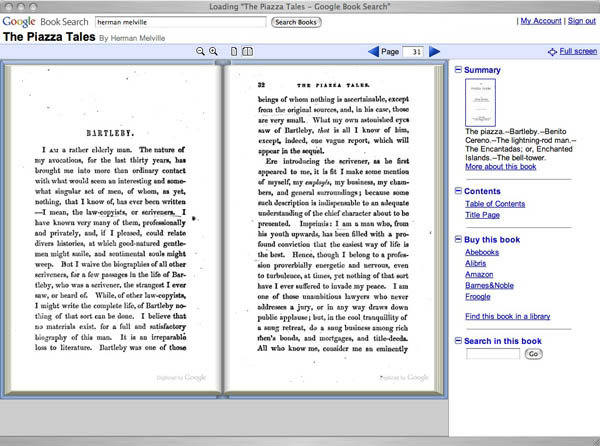
russian ideas, british delivery
This weekend I watched a performance of Voyage, the first part of Tom Stoppard’s new trilogy, The Coast of Utopia. It’s pure Stoppard: erudition delivered in a crossfire of dialogue and movement, skipping through time like a smartly thrown stone.
It is the story of young Russian intellectuals—Michael Bakunin, Nickolai Stankevich, Vissarion Belinsky, Alexander Herzen, Ivan Turgenev, Nicholas Ogarev—discovering foreign philosophy during the time of Tsar Nicholas I (a particularly conservative government). The young men, driven by Bakunin (played by Ethan Hawke), investigate the philosophies of Kant, Schelling, Goethe, Fichte, and Hegel. Bakunin ferociously pursues each philosopher and sprays his new knowledge at everyone he knows—most significantly his four sisters. By sharing books, writing letters, and expounding during summer visits to the family home he becomes the main vector of change in their lives. This first play is as much about the sisters’ struggle to withstand the shifting currents of MIchael’s idealism as it is about the early days of Russian intellectualism, or the last days of slavery in Russia, or the collision between ideas and reality.
Stoppard weaves these different themes together so deftly you can hardly tell where one ends and another begins. More importantly, it’s difficult to see how you could have one absent the others. The first act of the play is set at Premukhino, the Bakunin family estate, over the course of seven years. A phalanx of ragged bodies is set in the background, behind a sheer scrim representing the serfs. Their presence is constant, menacing, but generally unobtrusive to the Bakunin family, as they go about their own tumults brought on by one thing or another that Michael has done. At times you forget the serfs are there, and then, suddenly, you’ll look up and see the staggered rows of ragged bodies and a sense of foreboding descends.
The second act is set in Moscow, during the same seven years. Stoppard rewinds time to show us how events in the city led to the disruptions at Premukhino. The action in the city is invested with a sense of urgency, where the young men verbally joust as they try to define their latest position with regard to the newest book they’ve read. Moscow is a hotbed of anti-tsarist sentiment and foreign idealism. The political tension is high, the sensation of fear and revolt bubbles just below the surface. But Moscow is also an incubator for love, and it is there we witness the first real contact between humans, not just the meeting of like minds.
The play is a tour of European philosophy in the 1800’s, and it is highly ambitious (something you could say about any 9-hour trilogy, I suppose). But it is, nevertheless, gripping stuff. Billy Crudup does an amazing turn as Belinsky, completely inhabiting the character and committing to the moment. Ethan Hawke was fine as Bakunin, though his insouciance had a Reality Bites mopiness that seemed out of place in a young man who was struggling to bring Mother Russia into the modern era. The performance in the second act was more balanced and more powerful.
Prior to seeing the play I was concerned that the first act of a trilogy would have a sense of being open in the way a cliffhanger is open. I was watching it with two visitors from out of town, and it is unlikely they’ll be able to return to see Shipwrecked or Salvage. I didn’t want them to leave with a sense of the work being unfinished. While the action is indeed open-ended, there is a very strong sense of closure at the end of the second act. It is more portentous than unfinished: there is war and exile and a nobleman at the end of his life, contemplating the loss of his son and the dissolution of his estate. It is a nod to the great Russian novels, but with the unfussy delivery that I recognize from other Stoppard plays.
One of the things I kept noticing during the performance was the presence of books. When Stankevich passed a book to Bakunin, I felt the transfer of knowledge. The play expresses ideal of what we think about at the Institute: books as vehicles for big ideas. There is a treatise waiting to be written about the view of literature defining a nation (explosively presented in a monologue from Belinsky). And there is, throughout, a very powerful sense that the printed word is vastly important. But there is also that sense of impending loss, which makes us question where we are today. Do we live in a world where idealism is lost, and where the gilt-edged books filled with new philosophies are no longer valued? Or is it the opposite? Do we live in a world where the book is doing better than ever, and idealism takes so many forms that it is unrecognizable?
dutch fund audiovisual heritage to the tune of 173 million euros
Larry Lessig writes in Free Culture:
Why is it that the part of our culture that is recorded in newspapers remains perpetually accessible, while the part that is recorded on videotape is not? How is it that we’ve created a world where researchers trying to understand the effect of media on nineteenth-century America will have an easier time than researchers trying to understand the effect of media on twentieth-century America?
Twentieth century Holland, it turns out, will be easier to decipher:
The Netherlands Government announced in its annual budget proposal the support for the project “Images for the Future” (in Dutch). Images for the Future is a large-scale conservation and digitalisation operation comprising 285,000 hours of film, television and radio recordings, and 2.9 million photos. The investment of 173 million euro, is spread over a period of seven years.
…It is unprecedented in its scale and ambition. All these films, programmes and photos will be made available for educational and creative purposes. An infrastructure for digital distribution will also be developed. A basic collection will be made available without copyright or under a Creative Commons licence. Making this heritage digitally available will lead to innovative applications in the area of new media and the development of valuable services for the public. The income/expense analysis included in the project plan shows that on balance the project will produce a positive social effect in the Dutch economy to the value of 20 to 60 million euros.
— from Association of Moving Image Archivists list-server
Pretty inspiring stuff.
Eddie Izzard once described the Netherlandish brand of enlightenment in a nutshell: “The Dutch speak four languages and smoke marijuana!” We now see that they also deem it wise policy to support a comprehensive cultural infrastructure for the 21st century, enabling their citizens to read, quote and reuse the media that shapes their world (while they whiz around on bicycles over tidy networks of canals). Not so here in the States where the government works for the monopolies, keeping big media on the dole through Sonny Bono-style protectionism. We should pass our benighted politicos a little of what the Dutch are smoking.
terrain as browsing mechanism
Ben’s post last week, book as terrain, about converting any image to an interactive map with hotspots contained a link to a blog which collects info about all sorts of google map mashups. Ben’s post was about using book pages as geographic jumping-off points. However, as i read the endlessly fascinating list of other sorts of mashups it occurred to me that in addition to “book as terrain” we could also look at the idea of “Google map mashups” as a genuinely new form of expression. As I read through the wonderfully annotated list I realized that they cover the full gamut of subjects you would find in a bookstore . . . . Fiction, Non-Fiction, Travel, History, Sports, Games, Religion, Personal Growth, and Crime.
It’s interesting to realize that as our experience moves relentlessly into the virtual domain, that geography, which in the past was firmly rooted in the “real,” increasingly becomes the mechanism for organizing our activiites in virtual space.
laurels
We recently learned that the Institute has been honored in the Charleston Advisor‘s sixth annual Readers Choice Awards. The Advisor is a small but influential review of web technologies run by a highly respected coterie of librarians and information professionals, who also hold an important annual conference in (you guessed it) Charleston, South Carolina. We’ve been chosen for our work on the networked book:
The Institute for the Future of the Book is providing a creative new paradigm for monographic production as books move from print to the screen. This includes integration of multimedia, interviews with authors and inviting readers to comment on draft manuscripts.
A special award also went to Peter Suber for his tireless service on the Open Access News blog and the SPARC Open Access Forum. We’re grateful for this recognition, and to have been mentioned in such good company.
jonas mekas has a plan
Jonas Mekas was mentioned in passing on this blog last week, which seems fortuitous timing. Mekas has just announced (by video, of course) a plan to release a short film every day next year. All will be formatted for the video iPod; however, video formatted this way doesn’t need a video iPod for playback.
 Some background: Jonas Mekas is primarily an experimental film maker, having used film to document his life for the past fifty years. Along with Michael Apted’s 7 Up series, Mekas’s As I Was Moving Ahead, Occasionally I Saw Brief Glimpses of Beauty is one of the twentieth century’s great works of biography. He’s one of the most respected Lithuanian poets of the last century. And he’s also been a central force for avant-garde film culture in New York. Anthology Film Archives, his current cinema, presents an incredibly wide range of historical and contemporary film. It’s one of the great things about living in New York: the vast majority of what’s shown there simply isn’t distributed, and is inaccessible any other way.
Some background: Jonas Mekas is primarily an experimental film maker, having used film to document his life for the past fifty years. Along with Michael Apted’s 7 Up series, Mekas’s As I Was Moving Ahead, Occasionally I Saw Brief Glimpses of Beauty is one of the twentieth century’s great works of biography. He’s one of the most respected Lithuanian poets of the last century. And he’s also been a central force for avant-garde film culture in New York. Anthology Film Archives, his current cinema, presents an incredibly wide range of historical and contemporary film. It’s one of the great things about living in New York: the vast majority of what’s shown there simply isn’t distributed, and is inaccessible any other way.
Mekas has been taken in by the Maya Stendhal Gallery, which is currently hosting an exhibit of forty of his recent films (“recent” defined rather loosely). I spent an hour or so at the gallery yesterday; in the darkened space, flat-screen monitors present Mekas’s films on repeat. The selection of films at Maya Stendhal is tilted to the celebrity: there’s Andy Warhol at work, Salvador Dalí and Gala clowning about with broken-down cars somewhere in Chelsea, John Lennon and Yoko Ono’s bed-in in Montréal, Jackie Onassis at home, the elderly Carl Jung carving stones.
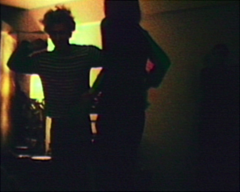 It’s a nice experience, but it’s difficult to actually watch the films there: the monitors are installed in series, so while watching one you can’t help but be distracted by what’s going on to the left and right. Mekas’s private epiphanies (Stan Brakhage making an enormous pile of pancakes for his children, for example) are interrupted by famous faces. But perhaps the most interesting thing about this exhibit isn’t actually going on in the gallery itself: the Maya Stendhal gallery is presenting the forty films online for public downloading. Currently, they’re available in iPod format – 320 x 240 pixel QuickTime files – but a few are available in high resolution: I downloaded a 665Mb file of the Velvet Underground’s first public appearance, at a psychiatrist’s convention in 1965. This is DVD quality: 720 x 576 pixels.
It’s a nice experience, but it’s difficult to actually watch the films there: the monitors are installed in series, so while watching one you can’t help but be distracted by what’s going on to the left and right. Mekas’s private epiphanies (Stan Brakhage making an enormous pile of pancakes for his children, for example) are interrupted by famous faces. But perhaps the most interesting thing about this exhibit isn’t actually going on in the gallery itself: the Maya Stendhal gallery is presenting the forty films online for public downloading. Currently, they’re available in iPod format – 320 x 240 pixel QuickTime files – but a few are available in high resolution: I downloaded a 665Mb file of the Velvet Underground’s first public appearance, at a psychiatrist’s convention in 1965. This is DVD quality: 720 x 576 pixels.
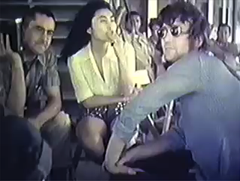 Mekas’s films aren’t free, but they’re relatively cheap: $3.99 for iPod quality, $6.99 for high resolution. The money isn’t going straight to Mekas: it’s going through the gallery. But there’s something that feels exciting about this: an artist taking over the reigns of distribution. This isn’t work that the general public is interested in; neither the artist nor the audience would be well-served by a regular distributor. Here there’s a more direct connection. Mekas curates an enormous library of film at Anthology Film Archives; it would be a tremendous achievement if that could be made available online.
Mekas’s films aren’t free, but they’re relatively cheap: $3.99 for iPod quality, $6.99 for high resolution. The money isn’t going straight to Mekas: it’s going through the gallery. But there’s something that feels exciting about this: an artist taking over the reigns of distribution. This isn’t work that the general public is interested in; neither the artist nor the audience would be well-served by a regular distributor. Here there’s a more direct connection. Mekas curates an enormous library of film at Anthology Film Archives; it would be a tremendous achievement if that could be made available online.
Mekas’s upcoming project to make a film a day and present it online is also interesting as an experiment in networked culture. Working online will create a much faster feedback loop for Mekas: there will almost certainly be a much greater role for the audience, not dissimilar to what we’ve been examining with our Thinking Out Loud series.
book as terrain
People have done all sorts of interesting things with Google maps, but this one I particularly like. Maplib lets you upload any image (the larger and higher res the better) into the Google map interface, turning the picture into a draggable, zoomable and annotatable terrain — a crude mashup tool that nonetheless suggests new spacial ways of navigating text.
I did a quick and dirty image mapping of W.H. Auden’s “Musee des Beaux Arts” onto Breughel’s “Landscape with the Fall of Icarus,” casting the shepherd as poet. Click the markers and then the details links to read the poem (hint: start with the shepherd).
As you can see, they give you the code to embed image maps on other sites. You can post comments on the individual markers right here on if:book, or if you go to the Maplib site itself you can add your own markers.
I quite like this one that someone uploaded of a southerly view of the Italian peninsula (unfortunately it seems to start larger images off-center):
And here’s an annotated Korean barbecue (yum):
